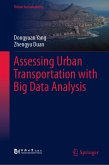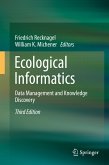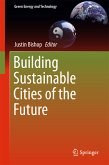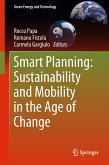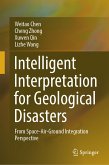Big Data Support of Urban Planning and Management (eBook, PDF)
The Experience in China
Redaktion: Shen, Zhenjiang; Li, Miaoyi


Alle Infos zum eBook verschenken

Big Data Support of Urban Planning and Management (eBook, PDF)
The Experience in China
Redaktion: Shen, Zhenjiang; Li, Miaoyi
- Format: PDF
- Merkliste
- Auf die Merkliste
- Bewerten Bewerten
- Teilen
- Produkt teilen
- Produkterinnerung
- Produkterinnerung

Hier können Sie sich einloggen

Bitte loggen Sie sich zunächst in Ihr Kundenkonto ein oder registrieren Sie sich bei bücher.de, um das eBook-Abo tolino select nutzen zu können.
In the era of big data, this book explores the new challenges of urban-rural planning and management from a practical perspective based on a multidisciplinary project. Researchers as contributors to this book have accomplished their projects by using big data and relevant data mining technologies for investigating the possibilities of big data, such as that obtained through cell phones, social network systems and smart cards instead of conventional survey data for urban planning support. This book showcases active researchers who share their experiences and ideas on human mobility,…mehr
- Geräte: PC
- ohne Kopierschutz
- eBook Hilfe
- Größe: 27.97MB
![Assessing Urban Transportation with Big Data Analysis (eBook, PDF) Assessing Urban Transportation with Big Data Analysis (eBook, PDF)]() Dongyuan YangAssessing Urban Transportation with Big Data Analysis (eBook, PDF)73,95 €
Dongyuan YangAssessing Urban Transportation with Big Data Analysis (eBook, PDF)73,95 €![Ecological Informatics (eBook, PDF) Ecological Informatics (eBook, PDF)]() Ecological Informatics (eBook, PDF)161,95 €
Ecological Informatics (eBook, PDF)161,95 €![Building Sustainable Cities of the Future (eBook, PDF) Building Sustainable Cities of the Future (eBook, PDF)]() Building Sustainable Cities of the Future (eBook, PDF)113,95 €
Building Sustainable Cities of the Future (eBook, PDF)113,95 €![Smart Planning: Sustainability and Mobility in the Age of Change (eBook, PDF) Smart Planning: Sustainability and Mobility in the Age of Change (eBook, PDF)]() Smart Planning: Sustainability and Mobility in the Age of Change (eBook, PDF)73,95 €
Smart Planning: Sustainability and Mobility in the Age of Change (eBook, PDF)73,95 €![Sustainable Transport Studies in Asia (eBook, PDF) Sustainable Transport Studies in Asia (eBook, PDF)]() Sustainable Transport Studies in Asia (eBook, PDF)73,95 €
Sustainable Transport Studies in Asia (eBook, PDF)73,95 €![Intelligent Interpretation for Geological Disasters (eBook, PDF) Intelligent Interpretation for Geological Disasters (eBook, PDF)]() Weitao ChenIntelligent Interpretation for Geological Disasters (eBook, PDF)121,95 €
Weitao ChenIntelligent Interpretation for Geological Disasters (eBook, PDF)121,95 €![Global Sustainability in Energy, Building, Infrastructure, Transportation, and Water Technology (eBook, PDF) Global Sustainability in Energy, Building, Infrastructure, Transportation, and Water Technology (eBook, PDF)]() Md. Faruque HossainGlobal Sustainability in Energy, Building, Infrastructure, Transportation, and Water Technology (eBook, PDF)73,95 €
Md. Faruque HossainGlobal Sustainability in Energy, Building, Infrastructure, Transportation, and Water Technology (eBook, PDF)73,95 €-
-
-
Dieser Download kann aus rechtlichen Gründen nur mit Rechnungsadresse in A, B, BG, CY, CZ, D, DK, EW, E, FIN, F, GR, HR, H, IRL, I, LT, L, LR, M, NL, PL, P, R, S, SLO, SK ausgeliefert werden.
- Produktdetails
- Verlag: Springer International Publishing
- Seitenzahl: 456
- Erscheinungstermin: 26. September 2017
- Englisch
- ISBN-13: 9783319519296
- Artikelnr.: 52945028
- Verlag: Springer International Publishing
- Seitenzahl: 456
- Erscheinungstermin: 26. September 2017
- Englisch
- ISBN-13: 9783319519296
- Artikelnr.: 52945028
- Herstellerkennzeichnung Die Herstellerinformationen sind derzeit nicht verfügbar.

